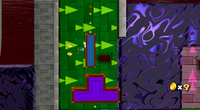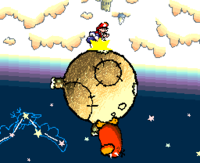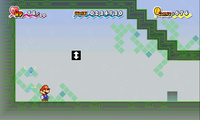Gravity: Difference between revisions
Scrooge200 (talk | contribs) |
mNo edit summary |
||
| Line 1: | Line 1: | ||
{{rewrite-expand}} | {{rewrite-expand}} | ||
[[File:SMG Dark Matter Plant Gravity Wall.png|thumb|Gravity pulls [[Mario]] towards the [[ | [[File:SMG Dark Matter Plant Gravity Wall.png|thumb|Gravity pulls [[Mario]] towards the [[dark matter]].]] | ||
'''Gravity''' is a theoretical force that draws two or more objects together. Some ''Mario'' games use gravity altering mechanics and have gameplay components which revolve around the alteration of gravity. | '''Gravity''' is a theoretical force that draws two or more objects together. Some ''Mario'' games use gravity altering mechanics and have gameplay components which revolve around the alteration of gravity. | ||
Revision as of 06:22, February 14, 2019
It has been requested that this article be rewritten and expanded to include more information.
Gravity is a theoretical force that draws two or more objects together. Some Mario games use gravity altering mechanics and have gameplay components which revolve around the alteration of gravity.
Appearances where gravity is altered
Super Mario World 2: Yoshi's Island
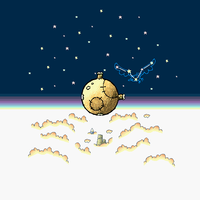
The only level in Super Mario World 2: Yoshi's Island that has altered gravity is Raphael The Raven's Castle during the boss fight. Yoshi must run around the moon and Ground Pound the Stumps to attack Raphael the Raven on the other side.
Yoshi Topsy-Turvy
In Yoshi Topsy-Turvy, gravity makes its first notable appearance in which it affects gameplay. If the player tilts the Game Boy Advance left or right, the world tilts accordingly. This element of gameplay doesn't appear in any other Mario or Yoshi game. Tilting the console causes items such as Boulders and enemies to roll in the according direction, and causes items such as apples to tilt in that direction as well.
Super Mario series
In Super Mario Galaxy and Super Mario Galaxy 2, there are many different forms of gravity in multiple levels. Black holes use gravity to draw Mario or Luigi into them, causing the player to lose a life. Some of the other planets have a longer reach and can pull Mario back to them no matter how far away he goes from them, unless he uses a Pull Star, Sling Star, or Launch Star. Gravity also appears as a force to be manipulated in several levels where it pulls Mario towards special walls called Gravity Walls. There are also two other manipulations of gravity in this game. There are Gravity Arrows, which change the gravity's flow in certain areas, and Gravity Spotlights, which either increase or decrease gravity, drawing Mario towards another place or allowing him to stick to other surfaces.
There are four different types of gravity in Super Mario Galaxy and Super Mario Galaxy 2:
- Normal gravity, which draws Mario in on all sides of the planet. This allows Mario to traverse the underside of a planet. An example of this is the mini-planets in the Gusty Garden Galaxy.
- Downward gravity, which pulls Mario down, regardless of the planet. This causes slopes that Mario cannot climb and also bottomless pits. An example of this is the Honeyhive Galaxy main planet.
- Outward gravity, which pulls Mario to the sides of a planet when he is inside one. This can happen in circular or cylindrical planets. An example of this is the Tower Planet in Bowser's Galaxy Reactor or the Warp Pipe area on the inside of the Asteroid Planet in the Good Egg Galaxy.
- Toroidal gravity, also referred to as "orbital" or "fall forever" gravity. This type of gravity occurs only on cylindrical planets. Instead of falling toward the planet, Mario will actually fall around the planet. Examples of this are on the Log Planet in the Tall Trunk Galaxy and on the Abandoned Rocketship Planet in the Space Storm Galaxy.
In Super Mario Odyssey, altered gravity appears in 8-Bit sections of some kingdoms using Gravity Walls. Some of these areas, such as ones seen in the Moon Kingdom have Mario hopping to circular planets with different gravity. The Moon Kingdom, Dark Side, and Darker Side also have lower gravity, which allows Mario to perform much higher jumps than usual.
Super Paper Mario
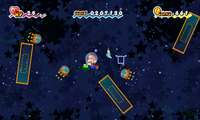
Chapter 4 of Super Paper Mario takes place in Outer Space. As such, gravity is different than in the rest of the game. In Chapters 4-1 and 4-3, gravity is nonexistent, allowing Mario and co. to navigate freely. Pressing any direction on the Wii Remote's D-Pad ![]() will automatically propel the player in the given direction. The player cannot stomp enemies in zero gravity and must instead use Squirps' Squirt Beam.
will automatically propel the player in the given direction. The player cannot stomp enemies in zero gravity and must instead use Squirps' Squirt Beam.
Chapter 4-2 takes place on Planet Blobule, which has low gravity, allowing the characters to jump much higher than normal and to fall much slower.
Chapter 4-4 takes place in the Whoa Zone, which has normal gravity. However, entering certain doors and pipes may place the characters on the walls or ceiling of a room. Later in the level, Gravity Switches are found, which change the direction of the player's personal gravity.
Mario Kart 8 / Mario Kart 8 Deluxe
Anti-gravity is a feature in the Mario Kart series, with the game Mario Kart 8 introducing it and reappearing in Mario Kart 8 Deluxe. The new mechanic allows vehicles to drive upside-down and vertically on courses. To activate these gravity directions, the karts must pass a special Dash Panel with circles on them.
